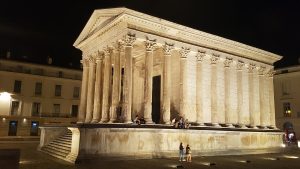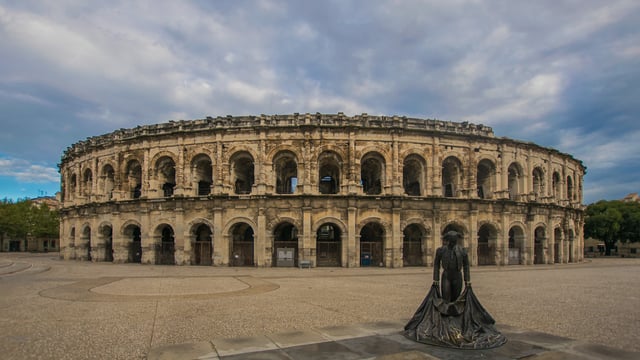Exploring the Roman World
About Our Travel Guide to the Roman World
This is not a history of the Roman Empire. Rather, it is a travel guide to the Roman world. A guide to the many and varied Roman ruins, landmarks, towns and museums in present-day countries in Europe, the Middle East and North Africa. Whether you want to visit a few of the more spectacular sites or are planning a more extensive trip to a specific area, you are sure to find what you need here. From recommendations for the best sites and museums to visit to thematic lists. From suggested itineraries to tools to create your own itinerary and travel lists. As well as many other resources, travel tips and ideas. The guide is produced by Thomas Dowson, an archaeologist and the founder of Archaeology Travel, along with contributions by other authors and researchers on this website. Read more about the authors and this website, as well as our mission and vision.
5 Must See Roman Sites

Colosseum


Hadrian’s Wall

Pompeii

Volubulis
From Italic Settlement to Roman Empire
The following very brief overview is intended to give an idea of how the Roman world changed geographically over the centuries. This serves as an introduction to our regional guides. A list of sources and recommended reading is provided as a starting point to learn more about the ‘rise and fall of the Roman Empire’.

Roman Kingdom 753 – 509 BC
Despite the fact that the origins of the city of Rome are shrouded in myth and legend, the Romans since at least the 3rd century BC, believed that Rome was founded by the legendary king Romulus on 21 April 753 BC. A date still celebrated in the Eternal City today. Rome’s foundation myth has many versions, but very little to no archaeological evidence to suggest either is an accurate account of the founding of Rome. Archaeologists and historians do not even agree on whether the twin brothers, rescued by a wolf on the banks of the Tiber River and raised by a shepard, were historical figures or not.



What the archaeological evidence does show is that there almost certainly was not one founding event. Rather, the area had been inhabited since at least the 15th century BC. In the 8th century BC hilltop villages came together forming a city state. Located on the banks of the Tiber River, the city occupied a strategic position allowing it to prosper through trade and agriculture.
From this time on, a period known as the Roman Kingdom or the regal period of ancient Roman, the city was ruled by kings. According to Roman historians, there were seven kings, Romulus being the legendary first king of Rome. As all historical documents were destroyed by the Gauls when they attacked the city following the Battle of the Allia around or shortly after 390 BC, the reigns of the named seven kings have not been confirmed by contemporary records.
At the end of the 6th century, Classical historians give 509 BC as the date, Rome instituted a new political system in which they were no longer ruled by kings chosen by virtue of their birth. The Roman Republic.
Roman Republic 509 BC–27 BC
In the new republic the king was replaced by two consuls and lesser magistrates who were elected annually by male citizens. The consuls appointed an advisory council, the Senate. To begin with, the wealthiest families, the so-called patricians, held considerable influence and power over civic and religious offices. Everyone else was considered plebeian, and could not hold office. At the end of the 5th century BC into the 4th the plebeians fought for and gained power within the government. Part of the solution here required more land to be acquired and given to the plebians.
And so begins Roman territorial expansion.
In around 396 BC the Roman army successfully attacks the Etruscans in the Battle of Veii. By 272 BC, specifically following the capture of Taranto in Apulia, much of the Italian peninsular was under Roman rule. From Etruria and Umbria in the north, to Campania and the Bay of Naples in the south, and then the Greek cities in southern Italy. It was only a few decades after this that the far north of what is Italy today came under Roman rule, albeit indirect for a while. The Battle of Telamon in 225 BC was the decisive conflict that removed the Celtic threat from the north of the peninsular.
Following the capture of Taranto the Romans turned their attention to Sicily, and so started a series of wars with Carthage (modern-day Tunis). Sicily became a province of Rome in 241 BC. In 238 BC Carthage surrendered Sardinia and Corsica.
The Second Punic War between the Carthaginians and the Romans was mostly fought on the Iberian peninsular. That war ended in 201 BC, with Carthage surrendering and relinquishing all control over Hispania. The two provinces there, Hispania Ulterior and Hispania Citerior were set up on 197 BC.
Tensions arose with the Macedonians when Philip V of Macedon took the side of Carthage against Rome, and declared war on Rome. A series of wars with the Macedonians ended in their defeated and the establishment of the province of Macedon in 146 BC. The same year that the Third Punic War (149–146 BC) ended in defeat and destruction of Carthage, and Rome setting up the Africa Proconsularis.
The province of Gallia Narbonensis (southern France) was established in 121 BC following the Roman defeating Gauls and other sea faring rivals while they were building a road from Italy to the Hispanic provinces for the supply of troops. Later, in 58 BC, Julius Caesar launched a series of military campaigns further north in Gaul, successfully incorporating it (France and Belgium) into Roman territory by 51 BC.
Roman Empire 27 BC - 476 AD
The transformation from Republic to Roman Empire has its origins in the turbulent period of the 1st century BC. Several political and military leaders emerged and challenging the traditional republican system. Among them was Julius Caesar, whose military conquests and political actions ultimately led to his dictatorship.
Caesar’s assassination in 44 BC sparked a power struggle between his adopted son, Octavian (later known as Augustus), and Mark Antony. After defeating Antony and Cleopatra in the Battle of Actium in 31 BC, Octavian became the uncontested ruler of Rome. In 27 BC, he officially proclaimed the end of the Roman Republic and the beginning of the Roman Empire. Under Augustus’ rule, the Roman Empire experienced a period of stability known as the Pax Romana (27 BC – 180 AD).
In 43 AD, Emperor Claudius initiated the Roman conquest of Britain, leading to the establishment of Roman rule over parts of modern-day England and Wales. In 63 BC Roman general Pompey conquered the region of Judaea, making it a client kingdom under Roman control. Following a Jewish rebellion in 66 AD, the Romans reasserted their dominance, resulting in the destruction of the Second Temple in Jerusalem in 70 AD.
Throughout the 1st century AD, Roman legions made several incursions into Germania, but the region was never fully conquered. The Rhine River became the boundary between Roman and Germanic territories. The Emperor Trajan launched military campaigns in the early 2nd century AD, adding the region of Dacia to the empire. Although it was later abandoned due to strategic reasons, it showcases the Roman Empire’s territorial ambitions.
During the third century AD, between specifically between 235 and 284 AD, the Roman Empire witnessed political instability, economic crises, and military uprisings. Emperors rose and fell rapidly, weakening central authority and dividing the empire. In the late 3rd century AD Emperor Diocletian implemented far reaching reforms to stabilize the empire. Significantly he divided it into the Eastern and Western Roman Empires, each with its own ruler and administrative bodies. The Western Roman Empire continued to suffer challenges from external invasions, particularly by Germanic tribes and the Huns. In 476 CE, the last Roman Emperor of the West, Romulus Augustulus, was deposed by the Germanic chieftain Odoacer, marking the traditional date for the fall of the Western Roman Empire.
Map of the Roman Empire at its Greatest Extent in 117 AD
Read More About the Roman Empire
The above history is intentionally brief to provide some context to the rise of Rome and the Republic, the shift to the Empire, and the expansion of Rome throughout the Mediterranean. The following three books are a good place to start to learn more about the Roman world, from its early beginnings to the shift of the political centre from Rome to the east.
- Kathryn Lomas, 2018, The Rise of Rome: from the Iron Age to the Punic Wars. Cambridge: Harvard University Press. (Available on Bookshop.org, and UK Bookshop.org).
- Greg Woolf, 2022, Rome: an Empire’s Story. Oxford: Oxford University Press. (Available on Bookshop.org and UK Bookshop.org)
- Judith Herrin, 2007, Byzantium: the Surprising Life of a Medieval Empire. London: Penguin Books. (Available on Bookshop.org and UK Bookshop.org)
Featured Destination

Nemausus ~ Roman Nîmes
From beef Bourguignon to Burgundy wines, the region that was once one of the most powerful medieval kingdoms in Europe today attracts visitors for its history and culture as it does its gastronomic heritage.
Best Preserved Roman Towns & Cities
Countries that Make Up the Roman World
From Portugal and Wales in the west to southwestern Iran in the East. From southern Egypt to Scotland in the north.


























